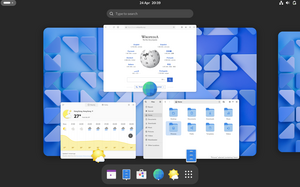GNOME Shell
 GNOME Shell in overview mode | |
| Developer(s) | GNOME project |
|---|---|
| Initial release | April 6, 2011 |
| Stable release | 3.0.1
/ April 27, 2011 |
| Repository | |
| Written in | Javascript and C[1] |
| Operating system | Unix-like |
| Available in | Multilanguage[2] |
| Type | Desktop environment |
| License | GNU General Public License |
| Website | live |
GNOME Shell is the core user interface of the GNOME desktop environment starting from version 3,[3] released on April 6, 2011. It provides basic functionality like switching between windows and launching applications. It replaces GNOME Panel[4] and other software components from GNOME 2 to offer a user experience that breaks from the desktop model used in previous versions of GNOME.
GNOME shell uses Mutter, a compositing window manager based on the Metacity window manager, and the Clutter toolkit to provide visual effects and hardware acceleration.[5] According to GNOME Shell maintainer[6] Owen Taylor, it is set up as a Mutter plugin largely written in Javascript.[7]
Features
Changes to the user interface (UI) include, but are not limited to:
- A new Activities overview, which houses:
- A messaging tray, an area at the bottom of the screen used for housing both interactive and static notifications separately from system status icons
- "Snapping" windows to screen borders to make them fill up a half of the screen or the whole screen
- A single window button, Close, instead of three. (Minimization has been removed due to the lack of a panel to minimize to, in favor of workspace window management. Maximization can be accomplished using the afore-mentioned window snapping.)
Reception
Critical reception of GNOME 3, and thus of its shell, has been positive,[8] although it has been criticized for a variety of reasons, mostly related to design decisions and reduced user control over the environment. For example, users in the free software community have raised concerns about the planned tight integration with Mutter will mean that users of GNOME Shell will not be able to switch to an alternative window manager without breaking their desktop. In particular, users will not be able to use Compiz while GNOME Shell is running.[9] Discussion between the developers of Compiz and GNOME have failed to resolve the issue. Another prominent complaint has been that GNOME Shell seriously reduces user control over the interface. For example, changing fonts and icon sets is not possible from the GUI in 3.0 although it is possible at the command line.[citation needed]
The release of GNOME 2 had resulted in similar response from the open source community, and GNOME's 2.x versions would ultimately go through several major revisions before the project arrived at what many considered maturity.[citation needed]
Gallery
-
Gnome Shell Overlay Mode Windows
-
Gnome Shell Overlay Mode Applications
References
- ^ "GNOME Shell is written in C and Javascript". Retrieved 2010-12-19.
- ^ "Translate GNOME Shell to your language". Retrieved 2011-02-14.
- ^ "Planning for GNOME 3.0". GNOME Live!. Retrieved 2011-03-23.
- ^ Apoorva Sharma (2010-03-23). "Why does Gnome-shell replace the current gnome-panel".
- ^ "Mutter: Window Manager in GNOME's Future - Linux Magazine Online". Retrieved 2011-03-23.
- ^ Paul Cutler (2009-07-01). "Behind the Scenes with Owen Taylor".
- ^ Owen Taylor (2009-03-23). "Metacity, Mutter, GNOME Shell, GNOME-2.28".
gnome-shell is set up as a Mutter plugin that is largely written in Javascript
- ^ "GNOME 3 is out: will Ubuntu reconsider? - ubuntu, open source, kde, gnome, canonical - Computerworld". Retrieved 2011-05-07.
- ^ Owen Taylor (2009-03-24). "Re: Metacity, Mutter, GNOME Shell, GNOME-2.28".
External links
- GNOME Shell homepage
- GNOME 3


